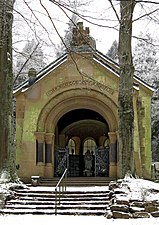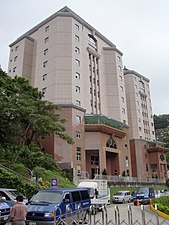Columbarium

Columbarium (also Columbarium ; from Latin columbarium 'dovecote, dovecote, dovecote' to columba 'dove') was originally the name for a dovecote . Because of the visual similarity, ancient Roman grave chambers with niches placed in rows on top of each other to hold urns after cremations were named that way. Today, a columbarium is a mostly above-ground structure that is used to store urns or coffins and is often attached to a cemetery or crematorium . Especially in southern countries columbaria are a widespread part of burial culture, here columbaria are often erected outdoors in the form of long, partially covered walls, often on the outer walls of the cemeteries.
history
The ancient columbaria discovered so far (more than 100 are known) can be found in Rome and its immediate vicinity and almost all date from the first century AD.As a rule, such columbaria were created by wealthy people, for their numerous slaves and freedmen as well had to worry after their death. Accordingly, these columbariums were simply built for the purpose of a burial that was as inexpensive as possible. The construction was half or completely underground. Clay ash pots ( ollae ) were used as urns, which were embedded in niches about half a meter wide. Marble tablets placed over the niches gave the names of those buried.
For free citizens who did not have the means to buy their own grave, speculators set up columbaria in Rome where they could buy a seat. Another variant was death fund companies, which secured the right to a decent burial and a burial niche for those involved in return for a one-off capital payment and regular contributions. Ultimately, columbaria were also donated by religious or commercial associations for their members. It should be mentioned in this context that in Christianity cremation has been rejected since the time of Charlemagne because of the literal interpretation of the idea of resurrection and was only accepted by the Catholic Church in the middle of the 20th century.
In addition to the urn burial, coffins with the dead are also kept in masonry columbarial cells. These buildings were often erected on the outer walls of some cemeteries in the form of so-called columbaria arcades . The aim of these structures was often an effective use of space, as in Verona or Brescia . In New Orleans this type of construction was chosen for flood protection reasons.
Columbaria in Germany
history
In Germany, this type of burial began to establish itself with the introduction of cremation in 1879. With the opening of the first crematorium in German-speaking countries in December 1878 at the main cemetery in Gotha , German columbaria were also built. Originally there was only a 50 m long columned hall in the Gotha crematorium, the urn colonnade built in the neoclassical style. When this was no longer sufficient, a columbarium was added in 1892.
The columbarium in the north cemetery in Wiesbaden was opened in 1902; it is executed in the neo-Romanesque style , but some details, such as the font design, already give an idea of the dawning Art Nouveau . It has 512 niches to hold urns. It was designed by the city architect Felix Genzmer . The columbarium at Stuttgart's Pragfriedhof is part of the crematorium designed in 1902 by Stuttgart architect Wilhelm Scholter in Art Nouveau style and inaugurated in 1907.
A columbarium that is under monument protection is the one in Leipzig's southern cemetery . At the rear, it adjoins the mourning hall complex opened in 1910 and built by Otto Wilhelm Scharenberg ; Its monument value is considered to be high and it is part of the largest cemetery structure in Germany. The walls are decorated with decorative elements and drawings. There is space for more than 2,800 urns in the wall niches. The columbarium and the urn chamber, which is in danger of collapsing, have been renovated since 2008 and opened to the public in May 2011 during the festival week for the 125th anniversary of the Leipzig South Cemetery.
In 1912 a columbarium was built for the Vohsen and von den Steinen families at the Friedrichsfelde central cemetery in Berlin . The tower-like building was built from natural stone on an artificial hill and provided with sparse exterior decoration: a triangular gable and a surrounding frieze with flowers and animal heads adorn it. The interior was clad with Elbe sandstone . Today the building is no longer used as a columbarium, but it is a listed building.
Current developments
Columbariums have been built again since the 1990s, for example one is located in the old part of the Braunschweig city cemetery .
The first columbarium in a church is the Appearance of Christ, opened in 2004 in the Krefeld parish church . In 2006 a second was built in Aachen's Church of the Holy Sepulcher St. Josef and in the diocese of Münster the first in the former Church of St. Konrad in the parish of St. Francis, Marl. In 2006, private columbariums also opened in funeral homes in Duisburg , Düsseldorf and Mülheim an der Ruhr . These were set up under the auspices of the Catholic Diocese of Old Catholics in Germany . With this carrier model, the columbarium is built and operated by the respective undertaker. There has been a columbarium in the All Saints' Church in Erfurt since 2007, and in 2008 a columbarium was inaugurated in the Evangelical Hope Church in Leverkusen .
In February 2010 the Columbarium Hl. Herz Jesu in Hanover was handed over to its destination. The Liebfrauenkirche in Dortmund was profaned and converted into the Church of the Holy Sepulcher by November 2010 . In August 2012 the crypt of the Catholic Mariendom in Hamburg , which was redesigned as a columbarium, was consecrated. In Mönchengladbach there have been the grave churches of St. Elisabeth and St. Matthias for urn burial since 2009, and the church of St. Joseph in Rheydt from the end of 2015. At the Ohlsdorf cemetery there are columbaria in chapels 8 and 11. There the urns are buried in wall niches. In the diocese of Muenster another two former parishes were opened as a columbarium: On October 2, 2013, the columbarium of St. Michael in Rheine and on 13 June 2014 in Datteln the columbarium of St. Anthony. In November 2013 the Südstadt Columbarium was opened in the Nazareth Church in Hanover . The Ahlbach Columbarium, opened in 2013, is Cologne's first columbarium with the Catholic Diocese of Old Catholics as the sponsor. The Church of St. Bartholomew in Cologne has been open since January 2014 . As the first and so far only Church of the Holy Sepulcher in the Archdiocese of Cologne , it was blessed and opened on January 24, 2014 by Auxiliary Bishop Manfred Melzer .
Other facilities
- In Japan and in the Chinese cultural area, columbaria in metropolitan areas are an alternative to cemeteries due to a lack of space and cost reasons.
- Columbarium of Pomponius Hylas in the Gardens of the Scipions , Rome, 1st century
- A columbarium built by Livia , the wife of Emperor Augustus, on the Via Appia in Rome, discovered in 1726, is preserved.
- The San Francisco Columbarium (USA) also houses an exhibition of extraordinary urns and coffins, such as the cookie jar ( cookie jar ) urn.
- In Salzburg , in the Mülln district , there is an old monk's columbarium with 60 burial niches under the Müllner Church .
- Examples
Columbarium in the casemates of the Theresienstadt ghetto
Columbarium at the north cemetery in Wiesbaden
Former columbarium in the Friedrichsfelde central cemetery
Columbarium in the Père Lachaise cemetery in Paris
Campo Verano , Rome
Contemporary columbarium in Ebingen
Columbarium in Duisburg- Duissern
Columbarium in the All Saints Church in Erfurt
Columbarium in the Vorwerker Friedhof in Lübeck
See also
literature
- Ernst Samter : Columbarium . In: Paulys Realencyclopadie der classischen Antiquity Science (RE). Volume IV, 1, Stuttgart 1900, Col. 593-603.
- Walter Hatto Gross : Columbarium. In: The Little Pauly (KlP). Volume 1, Stuttgart 1964, Col. 1250 f.
- H. v. Hesberg, M. Pfanner: An Augustan Columbarium in the Park of Villa Borghese. In: Jahrbuch des DAI 103 (1988), pp. 465-487.
- Clemens Leonhard, Thomas Schüller (Ed.): Dead in the Church? Legal and liturgical aspects of the profanation of churches and their conversion to columbaria. Verlag Friedrich Pustet, Regensburg 2012.
- Folkert Fendler, Thomas Klie, Sieglinde Sparre (eds.): Last home church: Columbaria in sacred spaces. Evangelical Publishing House, Leipzig 2014.
- Birgit Franz, Georg Maybaum, Walter Krings, with a theological contribution by Gunnar Jahn-Bettex: Houses of God as the final resting place? Columbaria in churches and chapels . Mitzkat Verlag, Holzminden 2011, ISBN 978-3-940751-30-0 (128 pages).
Web links
Individual evidence
- ^ Karl Ernst Georges : Comprehensive Latin-German concise dictionary . 8th, improved and increased edition. Hahnsche Buchhandlung, Hannover 1918 ( zeno.org [accessed June 24, 2019]).
- ^ Meyer's Large Conversational Lexicon . 6th edition. Bibliographisches Institut, Leipzig / Vienna 1909 ( zeno.org [accessed on June 24, 2019] Lexicon entry “Columbarium”).
- ^ Website of the Gotha Columbarium
- ↑ Leipziger Volkszeitung from July 19, 2007.
- ↑ Information about the columbarium at the Friedrichsfelde central cemetery, which has belonged to the Lichtenberg district of Berlin since 2001.
- ↑ Berlin State Monument List: Columbarium in the municipal central cemetery
- ^ Braunschweig cemetery administration
- ^ Columbarium in St.Franziskus Marl
- ↑ Website on Columbaria of the Catholic Diocese of Old Catholics in Germany
- ↑ St. Marien Cathedral Hamburg: Columbarium. ; see also: Hamburg novelty for eternity: Archbishop Thissen dedicates urn grave in Marien-Dom. domradio.de, August 16, 2012
- ↑ St. Elisabeth's Church of the Holy Sepulcher in Mönchengladbach
- ↑ St. Matthias Church of the Holy Sepulcher in Mönchengladbach ( Memento from January 17, 2016 in the Internet Archive ).
- ↑ St. Joseph's Church of the Holy Sepulcher in Mönchengladbach ( Memento from January 1, 2015 in the Internet Archive ).
- ^ Columbaria at the Ohlsdorf cemetery ( memento from September 23, 2011 in the Internet Archive ).
- ^ Columbarium St. Michael, Rheine
- ↑ Offers, events and news from the past: 2014: Opening of the St. Antonius Columbarium. Parish of St. Amandus Datteln.
- ^ Website of the Südstadt Columbarium
- ^ Website of the Ahlbach Columbarium
- ^ Website of the Church of the Holy Sepulcher St. Bartholomäus
- ^ Information on cemeteries in San Francisco
- ↑ Here, where beauty is the guardian of the dead ... (Nikolaus Lenau) . The former parish cemetery of Salzburg-Mülln and its monks' columbaria, ed. by Franz Lauterbacher OSB, Salzburg 2010.












